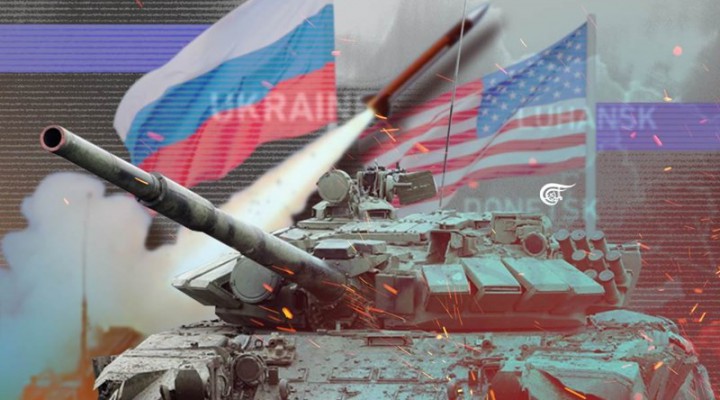A ‘Strategy Of Tension’

US dominance faces a multitude of threats worldwide. While the US sees Russian demands as unrealistic, Russia sees its red lines as an existential matter, and it seems ready to follow a calculated strategy of tension to make sure they are not bypassed.
These were President Putin’s words for describing Russia’s strategy to roll-back NATO’s incursion into the Asian heartland — an insertion that puts Russian security in existential jeopardy. Talks on the Russian draft security guarantees treaty begin in Geneva on 10 January, but from that point onwards, tensions are likely to escalate and widen geographically.
Why? Firstly, because we have seen a strategic shift in the US’ approach to Moscow’s insistence that NATO’s infrastructure be withdrawn completely from Russia’s near-abroad.
Initially, Washington’s reaction indicated it to have been taken somewhat by surprise by the publication of the Russian documents. The initial response then, was that though some of their contents were – for Washington – patently non-negotiable, others were not, and merited address. There was an implicit understanding to the US narrative then, of the points that Russia was making.
But after the holidays, the tone had changed radically: The Beltway think-tankers were either dismissive: the Russian demands were too outlandish even to merit consideration; or else, that Putin was providing Biden with a golden opportunity to clip Russian wings, before the US pivoted to tackle the bigger challenge posed by China.
The US narrative turned triumphalist: ‘Putin was damned either way’. That is, he would walk into an US-fuelled quagmire, were he to invade Ukraine; and lose massive face amongst Russians were he to back-down – to the point (the Beltway thinkers suggested), that it would imperil his future political prospects.
There was a touch of gloating in some of these comments, which, coming from the usual hawkish quarters, is to be expected. Their grabbing-hold of the narrative however, has been reflected (more diplomatically) at the official level too, with the White House being strictly non-committal over offering any security guarantees to Moscow, and in insisting that all sovereign states have the absolute right to opt to join NATO.
The second US shift has been in the structural approach to the talks: Russia had made clear from the outset that the dispute essentially was between Russia and the US, and that the crux of it was a matter to be settled between these two principals. The US, nonetheless, is trying to push the agenda sideways to the NATO-Russia dialogue, scheduled to take place in Brussels from 12 January.
Of course, the expanded participation complicates everything — it includes the Baltic States and Poland, who share a particular agenda toward Moscow. And the EU insists that they too should be involved in any talks that touch on European security architecture. Separately, Biden has spoken personally with President Zelensky to say ‘nothing (will be agreed) about you – without you’.
None of this will greatly surprise Moscow. They will have anticipated the possibility of such a reaction; though they will be on their guard, as they hear these Washington memes of Putin needing to be dismounted from his ‘high horse’; and the suggestion that Putin inadvertently has opened the path to Washington further salami-slicing into Ukraine (with arms sales, military advisers and private contractors – i.e. continuing the stealth NATO-isolation of Ukraine, without it formally becoming a NATO member).
So what next? This where Putin’s words about Russia’s ‘strategy of tensions’ becomes significant: If the talks fail to yield an early US undertaking about respecting Russia’s security ‘red lines’, the latter has already identified a calibrated ratchet of incremental military-technical steps that it will implement in response to any US attempt to kick the agenda into the ‘long grass’ of endless dialogue. Yes, Russia will pursue its strategy of steadily escalating tensions until the US accedes to its ‘red lines’.
Who knows where all this may lead? It seems that the war of tensions has already begun, even before the talks start. Recent events in Kazakhstan follow the pattern of a US classic colour-revolutionary play — in other words, Moscow will face pressures from the East as well as from a strategic Asian neighbour that shares a long border with both Russia and China. Kazakhstan is a pivotal state, both in terms of energy and as a trade corridor. It is ethnically Turkic, and has long been eyed by President Erdogan as a potential tool to his Turkic ‘homeland’ toolbox.
As western tensions rise with Russia, there is the probability of pushback from China: Kazakhstan borders (Turkic) Xinjian province, and America has just escalated its narrative on Taiwan – implying that Taiwan represents the anchor to America’s strategic partners in the Pacific region, and that Taiwan is a critical US regional ‘interest’ and security anchor. Beijing will have read these comments by a US official to the Senate as the ‘end of pretence’ that the US accepts Taiwan’s peaceful re-integration with mainland China.
Of course, in the longer-run, the US cannot prevail against China over Taiwan; nor do anything to stop any Russian intervention in Ukraine. It is more a case of the US ‘winning’ politically in its domestic arena — albeit at the cost of its long-term strategic positioning.
For Russia, the security issues are existential; but for Biden, the very prospect of clipping Russia’s wings offers (perhaps) a quick gig, by which he can balance-out the incompetence-overhang residing from his Afghan débacle. It is short-term domestic politics.
Washington has not been particularly adept at such gambles of late. And if badly handled, it could become a catastrophe for Biden, rather than the foreign policy feather in his cap – he so badly needs.
https://english.almayadeen.net/articles/analysis/a-strategy-of-tension
 TheAltWorld
TheAltWorld 
0 thoughts on “A ‘Strategy Of Tension’”